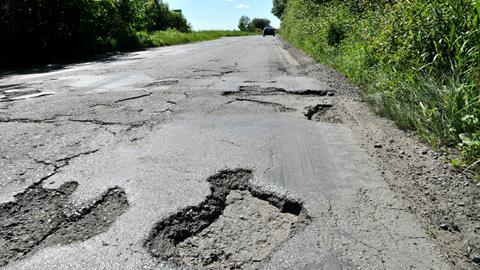The RAC is warning of a “pothole epidemic” after attending nearly 7,904 breakdowns in the first quarter of 2024, due to bad road surfaces, up 53% on the last three months of 2023.
Analysis from the automotive services company shows it’s been a bumpy start to the year for drivers, with pothole-related breakdown numbers up by 9% in the 12 months to 31 March 2024.
The RAC went out to 27,205 breakdowns, 2,299 more than the 24,906 incidents it attended in the 12 months to 31 March 2023.
However, the RAC notes that the results in the first three months of this year could have been worse but for milder weather, which saw patrol call-out rates dropping by 22% from 10,076 in the first quarter of 2023, to 7,094 in the same period in 2024.
During the winter months, sub-zero temperatures normally cause more surface deterioration as water gets into cracks in the road, freezes and expands. In the first three months of 2024, there was an average of 121mm of rain – 22% more than normal – resulting in only seven days of frost, against the usual average of nine. This potentially limited the number of brand new potholes forming.
RAC argues that this decrease in pothole-related breakdowns, in what is usually the worst quarter of the year for pothole related breakdowns, is not a sign of road conditions improving. It points out that, compared to 2006, when the RAC first began tracking these faults, drivers are now 76% more likely to experience pothole damage.
RAC head of policy Simon Williams said: “While our data shows pothole damage to vehicles in the first three months of this year is lower than it was in the same period in 2023, it’s important not to lose sight of the bigger picture and the ongoing miserable state of our roads. The analysis clearly shows drivers are now twice as likely to suffer a breakdown due to sub-standard road surfaces as they were in 2006.
“While many would rightly say the roads are terrible, we believe they would have been far worse had we not had such a mild winter. We feel drivers have dodged the pothole bullet as the lack of widespread sub-zero temperatures has masked the true state of our roads.
“After all, all the cracks left by years of declining road maintenance budgets can’t easily be filled. Even though the government has given councils an additional £8.3bn for road maintenance from the cancellation of the northern leg of HS2, we know this is only enough to resurface 5,000 miles of roads – the equivalent of just 3% of all England’s local roads.
“To make the most of this funding, we implore local authorities to focus their efforts on resurfacing the worst roads in their areas rather than pointlessly trying to patch pothole-ridden roads that can’t be saved from further decline.
”And now is the time for preventative action to be taken, as it’s between the warmer months of April and September when vital surface dressing work can be carried out to extend the life of roads. Sadly, government data we analysed shows 60% of English councils didn’t do any such work in the 2022-2023 financial year.
“Drivers frustrated by the UK’s pothole epidemic can highlight the problem by downloading and using Stan, a new free mobile app capable of automatically detecting road defects via a smartphone camera mounted in a cradle.
”The data is helping build the UK’s first ever national map of road surface issues. The RAC is urging local authorities to use the data to locate problems on their networks and carry out repairs quickly and efficiently.”
Stan, which is available for both Apple and Android devices, uses a smartphone’s in-built camera together with computer vision technology to automatically and accurately identify road defects, such as potholes. The data is recorded with the phone in a cradle, meaning there is no need to interact with it.
RAC is calling for drivers to download the app so that it can deliver a more accurate picture of just how bad some of the UK’s roads are. Data collected by drivers is passed to councils to encourage them to prioritise road repairs more effectively, to pressure councils to fix their roads, and to argue for greater government spending on road maintenance.
In November last year Transport Secretary Mark Harper announced an £8.3bn long-term plan to resurface over 5,000 miles of road across the country over the next 11 years. The strategy saw local highway authorities in England receive £150m in the financial year 2022/23. This will be followed by a further £150m for 2024/2025, with the rest of the funding allocated through to 2034.
The £8.3bn is divided, with £3.3 billion for local authorities in the North West, North East and Yorkshire and the Humber; £2.2bn for local authorities in the West Midlands and East Midlands; and £2.8bn for local authorities in the East of England, South East, South West and, for the first time in 8 years, London.
Reacting to the RAC report, James Barwise, RHA policy lead, said: “We welcome the government’s recent announcements around the £8bn worth of funding to repair potholes.
”However, it is important that this funding is ringfenced and paired with other funding sources. If local authorities are provided with the tools to get on with the job, the cost of repairing potholes decreases considerably.”

















